HttpClient in Unity
On a code review of some Unity code where HttpClient was being used, a comment was made to
“Consider using HttpClientFactory”. Those three words resulted in many hours of intrigue and
frustration, which I will document here.
Why we have HttpClientFactory
First, some background: Why does HttpClientFactory exist? There’s a long and sordid history to this.
An (in)famous post titled “You’re using HttpClient wrong and it is destabilizing your software” at
https://www.aspnetmonsters.com/2016/08/2016-08-27-httpclientwrong/ outlines the first problem. Namely,
although HttpClient implements the IDispose interface, you shouldn’t be spinning them up and disposing
them regularly. By default this will create new network connections for each HttpClient instance, and
then leave them in a TIME_WAIT state for a couple mins when disposed. Beside the fact creating new
connections is expensive (with the TCP handshake and SSL overheaded on each new connection), every
network connection you leave in this state is consuming resources, and at the extreme end you get
“socket exhaustion”, where you literally run out of TCP/IP sockets to allocate.
So the outcome of that article is that you should allocate a static HttpClient and just continue to
use it, thus reusing the network connections is allocates. This however, results in another serious
problem as outlined in “Singleton HttpClient? Beware of this serious behavior and how to fix it” at
http://byterot.blogspot.com/2016/07/singleton-httpclient-dns.html. Basically the problem with using
a single HttpClient and continually reusing the connections, is that DNS changes will now never get
picked up. Various performance and reliability solutions on the internet (such as
Azure Front Door)
use DNS changes to route clients to different endpoints depending on load and health. Some deployment
features such as A/B testing or switching staging slots can also be implemented via DNS changes.
The solution to this is to use HttpClientFactory to get a new HttpClient on demand. Under the
covers it handles persisting connections for a couple of minutes (even when the HttpClient is disposed)
and also spinning up new connections regularly to pick up any DNS changes. You can read more about
how to use it on the doc page Use IHttpClientFactory to implement resilient HTTP requests.
So just use that right?
Unity and .NET
(Note: My specific Unity project is using the .NET 4.x profile, so those are the APIs this post will cover)
Unity doesn’t use the “official” .NET 4.x Framework. It also doesn’t use .NET Core. It’s version of
.NET is from the Mono project. (Actually a fork of this project, but
that’s not important for now). As can be seen on their doc page .NET Profile Support,
Unity support .NET 4.x and .NET Standard 2.0 profiles. Unfortunately HttpClientFactory was added in
.NET Core 2.1 (which is .NET Standard 2.1).
But all is not lost. HttpClientFactory itself is contained in the NuGet package “Microsoft.Extensions.Http”,
and if you look on NuGet at https://www.nuget.org/packages/Microsoft.Extensions.Http/, you can see
this supports .NET Standard 2.0. However it has a loooooong dependency graph, depending on other packages
for Logging, Options, DependencyInjection, etc. Beside the pain of getting NuGet packages into a Unity
application, requiring the manual download and unzipping of packages (see this documentation page),
there is another pain point.
HttpClientFactory and DI
The only way to use HttpClientFactory is via dependency injection, which also requires you to use
the .NET hosting model. The only way to get an IHttpClientFactory interface (needed to create
the HttpClient instances) is via dependency injection, by calling the extension method AddHttpClient
on an IServiceCollection, and then having the hosting model create the instances where it is needed.
You can see on the GitHub issue at https://github.com/aspnet/HttpClientFactory/issues/55 where ways
to use HttpClientFactory without depending on Dependency Injection and the associated hosting model
have been requested, but at the moment that is still required.
I did not want to add a long list of NuGet packages and restructure the Unity app to use an IServiceProvider
and Dependency Injection, so HttpClientFactory was off the table.
Mono thwarts other avenues
If we revisit the Uber-issue on GitHub, and specifically this comment you’ll notice the below:
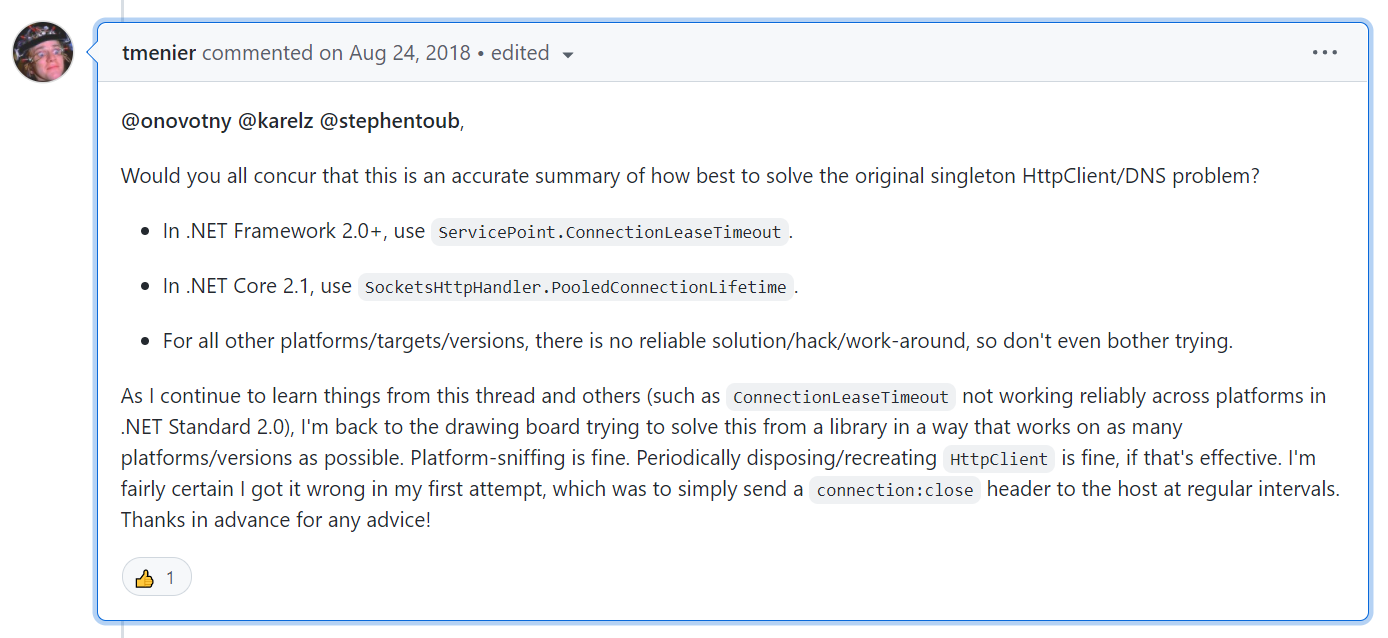
Notice the ”..not working reliably across platforms..” bit. Sadly, Mono is one of those platforms. Using
ILSpy on the Mono version of System.Net.Http.dll versus the other .NET implementations, it can been seen
there are many things that are simply not implemented. Sadly, ServicePoint.ConnectionLeaseTimeout is one of them.
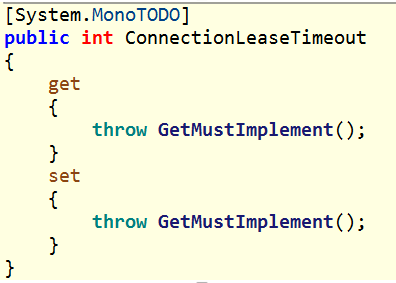
This left but one option: Figure out how all this fits together and write a custom solution.
How HttpClient works in Mono
The HttpCient class itself doesn’t create and destroy network connections. The class relationships
that map between an HttpClient instance and a network socket is very convoluted. I ended up mapping
out and diagramming over 20 class types, and that was just to get a high level understanding. The crux
of the issue though is that HttpClient is a very thin wrapper, and delegates much of its work to
HttpClientHandler, which creates a network connection “group”. When you create a new HttpClient
via its default constructor, it creates its own HttpClientHandler, and then when you call Dispose()
on this HttpClient, it calls Dispose() on its HttpClientHandler, which closes the network connection
group. You can see this code at this line in the Unity Mono fork
HttpClient itself largely just delegates to HttpMessageInvoker, and it can be seen from its constructor
that you can provider an HttpMessageHandler (which HttpClientHandler derives from), and also tell
it not to dispose this message handler when it is disposed. This is the key to sharing connections
across HttpClient instances.
So that seemed easy enough. Just create all the HttpClient instances using one HttpClientHandler
for a couple mins to share the connections, then periodically start using a new HttpClientHandler to
cycle through the connections and pick up DNS changes. (This is effectively what HttpClientFactory does).
But that then left me with a few questions, namely:
- So when should the
HttpMessageHandlerbe disposed? How do you know when its connections are no longer in use (i.e. requests/responses have completed). You don’t want to kill the connections while requests are still in progress. - If I return just the response stream from a method, and the
HttpClientis diposed, and the activeHttpClientHandlerhas been replaced, will garbage collection potentially run and kill the (possibly in flight) connections?
Cut to the chase
Long story short, while calling Dispose() explicitly on the HttpClientHandler kills the connection
group, that class doesn’t have a finalizer (a destructor, in C# parlance). So when the garbage collector
cleans up an HttpClientHandler, no code is invoked, and Dipose(false) is not called to clean up
unmanaged resources.
The connections themselves are managed by a ServicePointScheduler, which tracks when an operation
completes on a connection and will then close it when idle. See this code in the Mono repository
Effectively HttpClient and HttpClientHandler are just factories to create HttpResponseMessage
objects (and corresponding HttpRequestMessage) against a specific ConnectionGroup. They do not
hold any references to these objects, and refer to the ConnectionGroup by name only, as seen below.
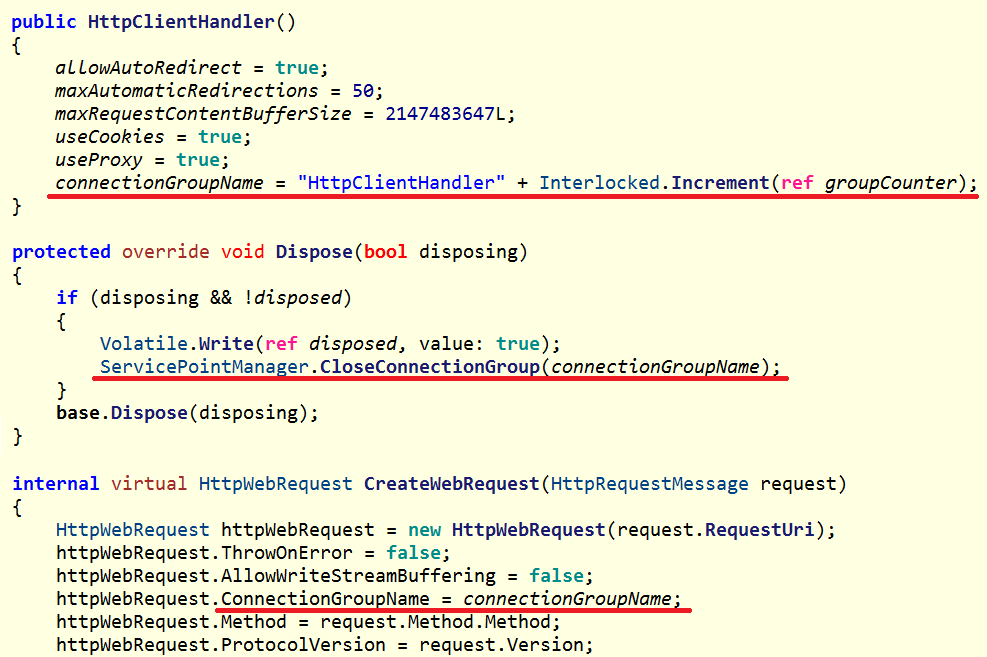
As long as you don’t explicitly Dispose the underlying HttpClientHandler, but instead provide your
own and simply stop using it and leave to the GC to clean up when done, all is good.
This allows for both the HttpClient to be disposed (which doesn’t dispose the provided HttpClientHandler),
and for the HttpClientHandler to be garbage collected when no longer referenced, without killing any
in use connections. The ServicePoint manages the active connections, and will clean them up when no longer used.
Implmenting a UnityHttpClient with this approach allows for code such as the below, which returns only a stream, and the connection will remain
active until the response is completed, even after the HttpClient and the underlying HttpClientHandler
have long gone. The class will start using a new HttpClientHandler periodically to allocate new connections.
async Task<Stream> GetHttpStream()
{
using var client = UnityHttpClient.Get();
var stream = await client.GetStreamAsync("https://localhost:5001/api/blob");
return stream;
}
Using the excellent Memory Profilers Package
in Unity, from the stream returned above, we can see it reference down to the underlying network socket.
Also shown is the ServicePoint which holds a reference to outstanding operations and current network
connections, (as well as idle connections to be cleaned up after the idle timeout). References
of interest have been underlined.
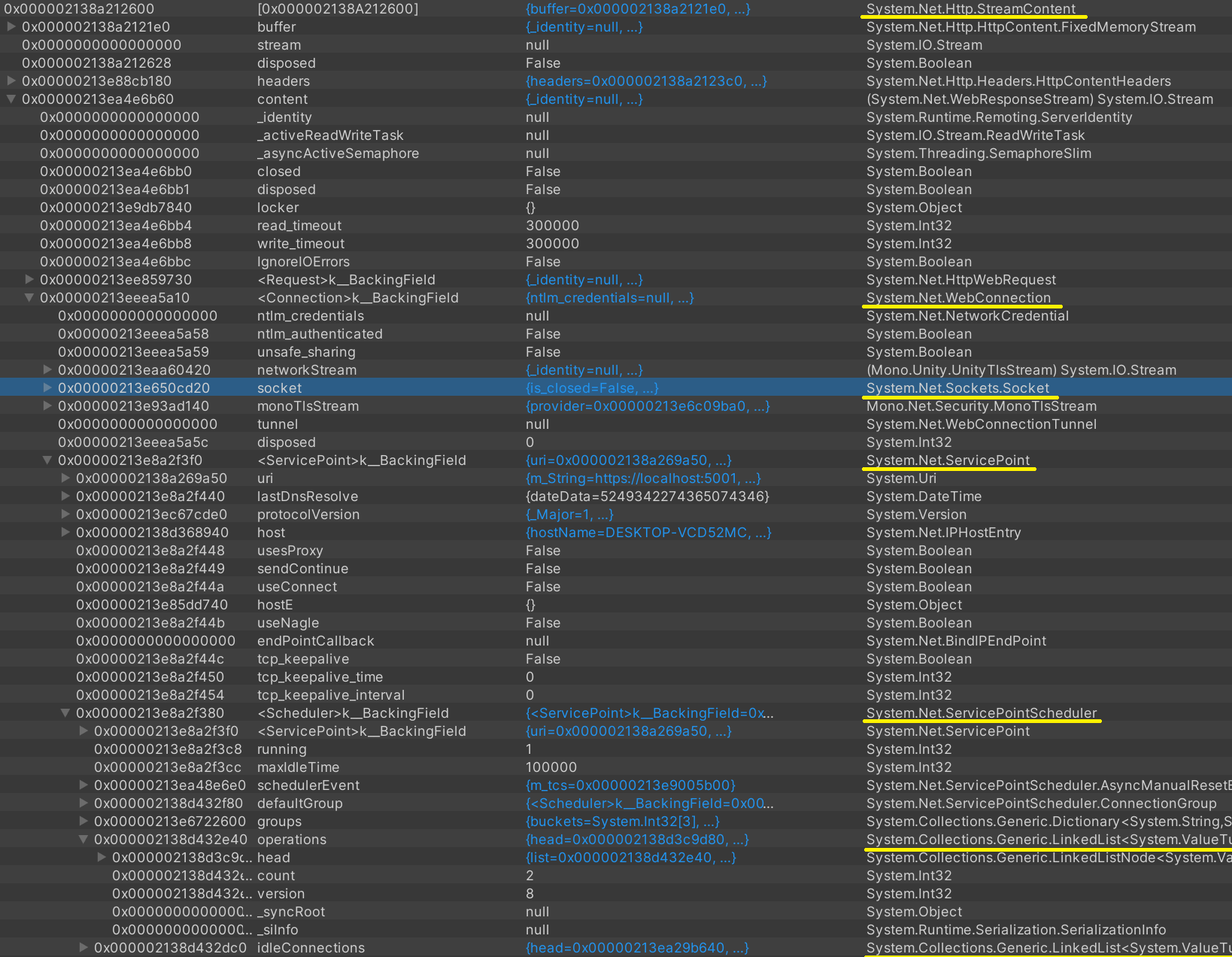
Writing the Unity HttpClient factory
With the above in mind, how should the UnityClientFactory look? Below is the
implementation I came up with. Note this allows for “named” clients to explicitly get
a new set of connections (as outlined in the comments).
public class UnityHttpClient
{
private const int handlerExpirySeconds = 120;
private static readonly object factoryLock = new object();
private static readonly Dictionary<string, UnityHttpClient> factories =
new Dictionary<string, UnityHttpClient>()
{
{ string.Empty, new UnityHttpClient() }
};
public static HttpClient Get() => factories[string.Empty].GetNewHttpClient();
// Each unique HttpClientHandler gets a new Connection limit per origin, so create
// a new "named" client factory to get a new handler (used by each HttpClient from
// that factory), and thus new set of connections.
//
// For example, if you have a few long-running requests, you might choose to put
// them on their own handler/connections so you don't block other faster requests
// to the same host.
public static HttpClient Get(string name)
{
UnityHttpClient factory;
lock (factoryLock)
{
if (!factories.TryGetValue(name, out factory))
{
factory = new UnityHttpClient();
factories.Add(name, factory);
}
}
return factory.GetNewHttpClient();
}
private HttpClientHandler _currentHandler = new HttpClientHandler();
private readonly Stopwatch _handlerTimer = new Stopwatch();
private readonly object _handlerLock = new object();
private UnityHttpClient() { }
private HttpClient GetNewHttpClient() =>
new HttpClient(GetHandler(), disposeHandler: false);
private HttpClientHandler GetHandler()
{
lock(_handlerLock)
{
if (_handlerTimer.Elapsed.TotalSeconds > handlerExpirySeconds)
{
// Leave the old HttpClientHandler for the GC. DON'T Dispose() it!
_currentHandler = new HttpClientHandler();
_handlerTimer.Restart();
}
return _currentHandler;
}
}
}
Testing
To verify the code behaves as desired, I created a simple web service that has two REST APIs. The
first /api/item generates small and fast responses, and the second /api/blob for large and slow
responses. This simple web server can be written in a few lines of C# code using top-level statements
(as introduced in C# 9). The entire ASP.NET Core 5 project code is shown below:
using System;
using System.Diagnostics;
using System.Text;
using System.Threading;
using System.Threading.Tasks;
using Microsoft.AspNetCore.Builder;
using Microsoft.AspNetCore.Hosting;
using Microsoft.Extensions.Hosting;
int requestId = 0;
var builder = Host.CreateDefaultBuilder().ConfigureWebHostDefaults(webBuilder =>
{
webBuilder.Configure(app =>
{
// Fast and small JSON response
app.Map("/api/item", app =>
{
app.Run(async context =>
{
int itemId = Interlocked.Increment(ref requestId);
byte[] body = Encoding.UTF8.GetBytes($"}");
context.Response.StatusCode = 200;
context.Response.ContentLength = body.Length;
context.Response.ContentType = "application/json";
await context.Response.BodyWriter.WriteAsync(body.AsMemory());
await context.Response.CompleteAsync();
});
});
// Large and slow binary response
app.Map("/api/blob", app =>
{
app.Run(async context =>
{
Stopwatch chunkTimer = Stopwatch.StartNew();
const int contentLength = 1024 * 1024 * 10; // 10 MB
const int chunkSize = 1024 * 16; // in 16kb chunks
const int responseTimeMs = 10000; // Response to take 10 sec
Debug.Assert(chunkSize % 128 == 0 && contentLength % chunkSize == 0,
"chunkSize must be multiple of 128 and divide into contentLength");
context.Response.StatusCode = 200;
context.Response.ContentLength = contentLength;
context.Response.ContentType = "application/octet-stream";
int bytesWritten = 0;
while (bytesWritten < contentLength)
{
StringBuilder content = new(chunkSize);
while (content.Length < chunkSize)
{
string txt = $"{bytesWritten + 128} bytes including this line"
.PadRight(127, '-') + "\n";
content.Append(txt);
bytesWritten += 128;
}
byte[] chunk = Encoding.UTF8.GetBytes(content.ToString());
Debug.Assert(chunk.Length == chunkSize);
await context.Response.BodyWriter.WriteAsync(chunk.AsMemory());
// Delay each chunk so the request takes the desired time
double percentComplete = (double)bytesWritten / contentLength;
long durationSoFarMs = chunkTimer.ElapsedMilliseconds;
int delayMs =
(int)(percentComplete * responseTimeMs - durationSoFarMs);
if (delayMs > 0) await Task.Delay(delayMs);
}
await context.Response.CompleteAsync();
});
});
});
});
builder.Build().Run();
Using dedicated connections
Below shows the code to test the service. Of particular interest are lines 6 & 7, where the requests to the large and slow endpoint can either use the default handler, or be configured with their own handler. For the initial tests we’ll put everything on the same handler.
This code sends a new request every second. Note the condition if (reqId % 3 == 0) {...} that
causes every third request to be to the slow API.
public class MyDownloader : MonoBehaviour
{
async Task<Stream> GetHttpStream()
{
// *** Switch which line is commented out below to use a dedicated handler ***
// using var client = UnityHttpClient.Get("slow");
using var client = UnityHttpClient.Get();
var stream = await client.GetStreamAsync("https://localhost:5001/api/blob");
return stream;
}
async Task<HttpResponseMessage> GetHttpRequest()
{
using var client = UnityHttpClient.Get();
var req = await client.GetAsync("https://localhost:5001/api/item");
if (req.StatusCode != System.Net.HttpStatusCode.OK)
{
throw new ApplicationException("Error");
}
return req;
}
bool doRequests = false;
int requestId = 0;
Stopwatch timer;
void Start()
{
LogMsg($"Starting downloader.");
timer = Stopwatch.StartNew();
}
void LogMsg(string msg) =>
Debug.Log(msg + $" ThreadId: {Thread.CurrentThread.ManagedThreadId}");
void Update()
{
if (!doRequests) return;
// Every second start a new request
if (timer.ElapsedMilliseconds >= 1000)
{
timer.Restart();
int reqId = Interlocked.Increment(ref requestId);
Task.Run(async () =>
{
if (reqId % 3 == 0)
{
// One in three requests is for a large/slow item.
Debug.Log($"Request {reqId} starting for slow blob. " +
$"ThreadId: {Thread.CurrentThread.ManagedThreadId}");
var stream = await GetHttpStream();
// On a separate thread, read the stream to completion.
_ = stream.CopyToAsync(Stream.Null).ContinueWith(_ =>
LogMsg($"Request {reqId} completed for slow blob."));
}
else
{
LogMsg($"Request {reqId} starting for fast json.");
var request = await GetHttpRequest();
LogMsg($"Request {reqId} completed for fast json.");
}
});
}
}
void OnMouseDown()
{
doRequests = !doRequests;
}
}
Running this code as-is we can see that pretty soon even the “quick” requests are getting backed up waiting for the slow requests to complete. The initial “fast” requests number 1, 2, 4, and 5 all complete within the expect 1 sec time. But once the second “slow” request starts (request 6), we see that all requests start taking a while to complete, as the two connections per origin limit is consumed with running the slow requests.
Log with one handler
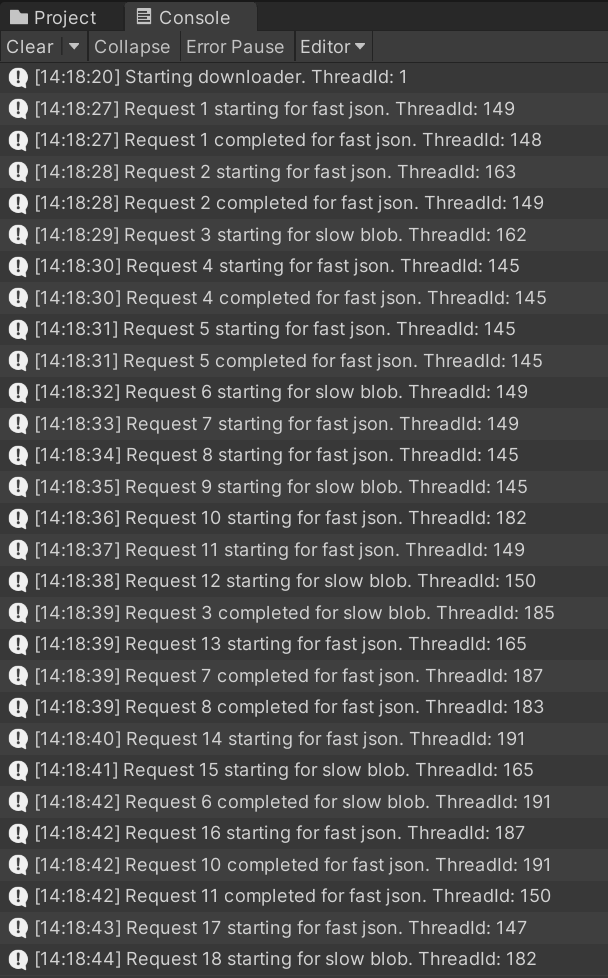
If we look at the object in memory, we can see in the scheduler that the default two connections are allocated, and there are a queue of operations waiting to run.
Objects with one handler
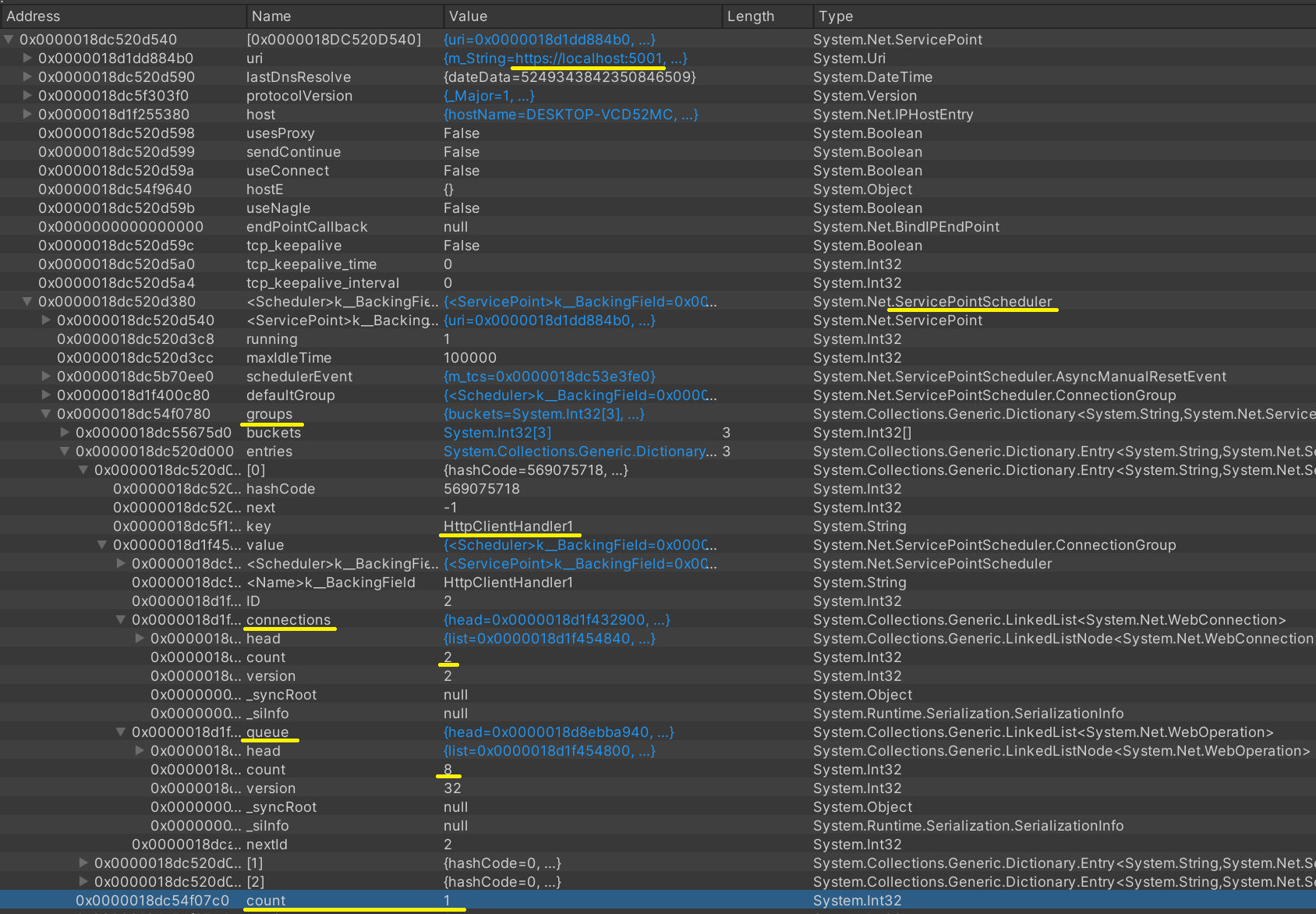
Adding an additional handler
If we uncomment line 6 and comment out line 7, so that GetHttpStream is using its own dedicated
handler group (named “slow”), we see that now all the fast API requests are completing immediately,
even as the slow API requests start to queue up.
Log with slow handler
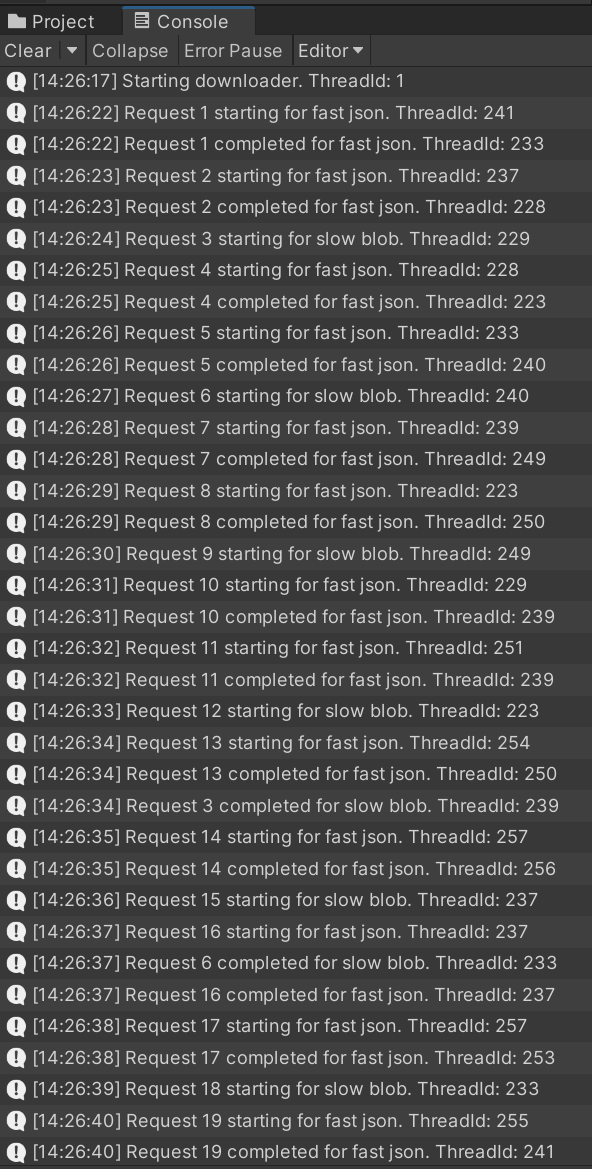
The objects in memory show us that there are now two ConnectionGroup objects contained within the
ServicePointScheduler, and that the group named HttpClientHandler1 (the first group created for
the fast requests) has an emtpy queue - even with slow requests waiting. Meanwhile the group created
for the slow requests, HttpClientHandler2, has a couple items in the queue (as well as operations
currently in progress).
Objects with slow handler
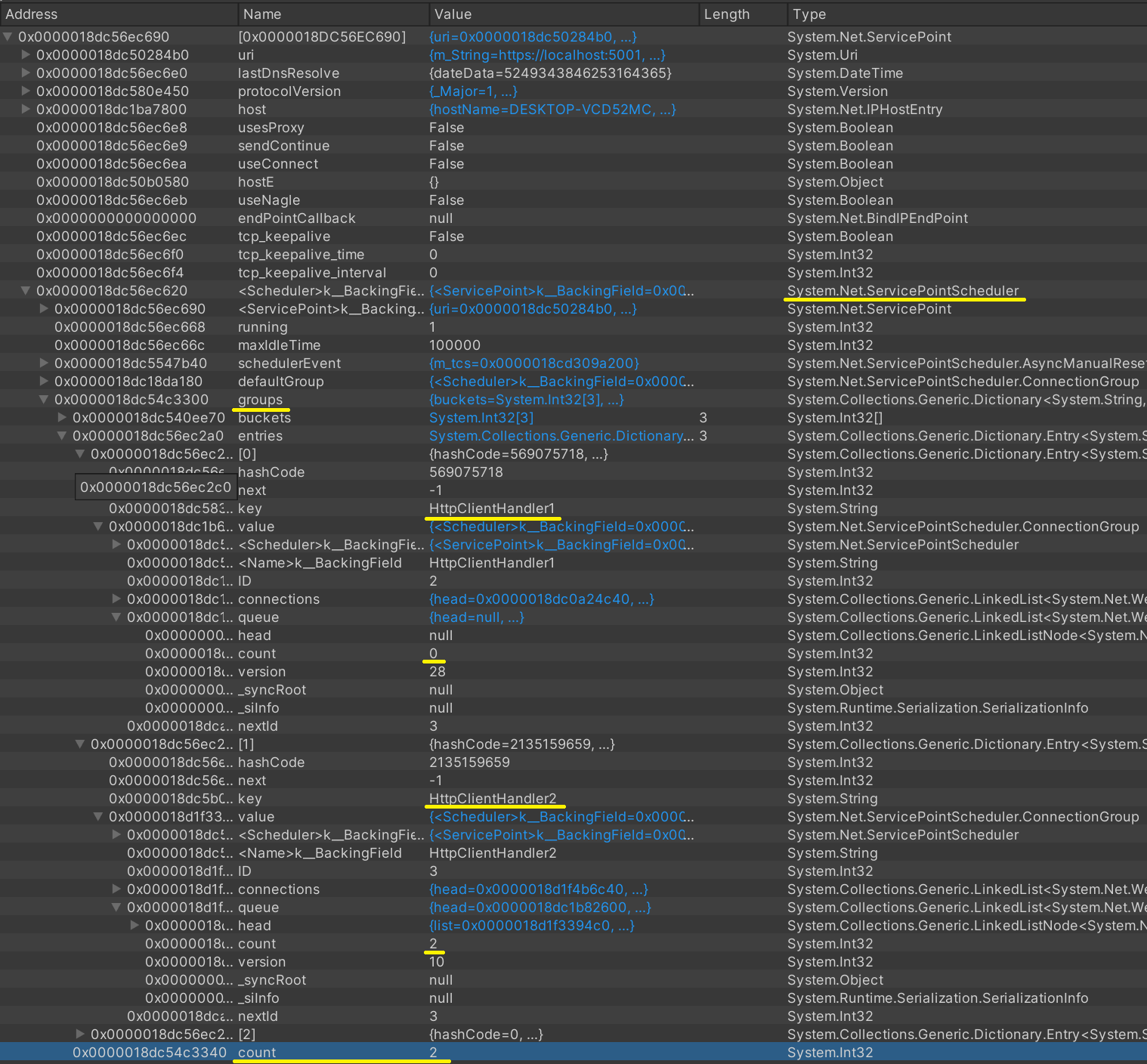
This shows that being able to provide a “named” connection group can avoid contention and blocking for requests on other groups.